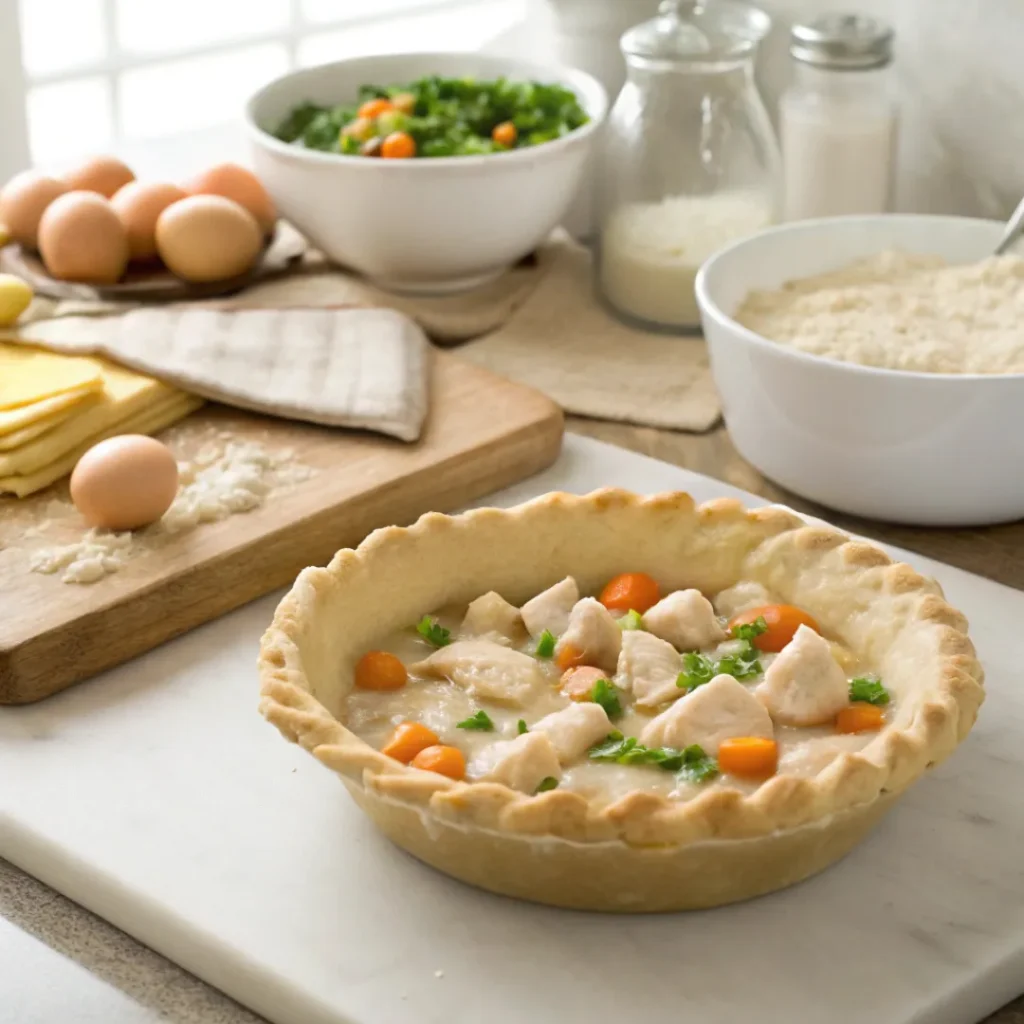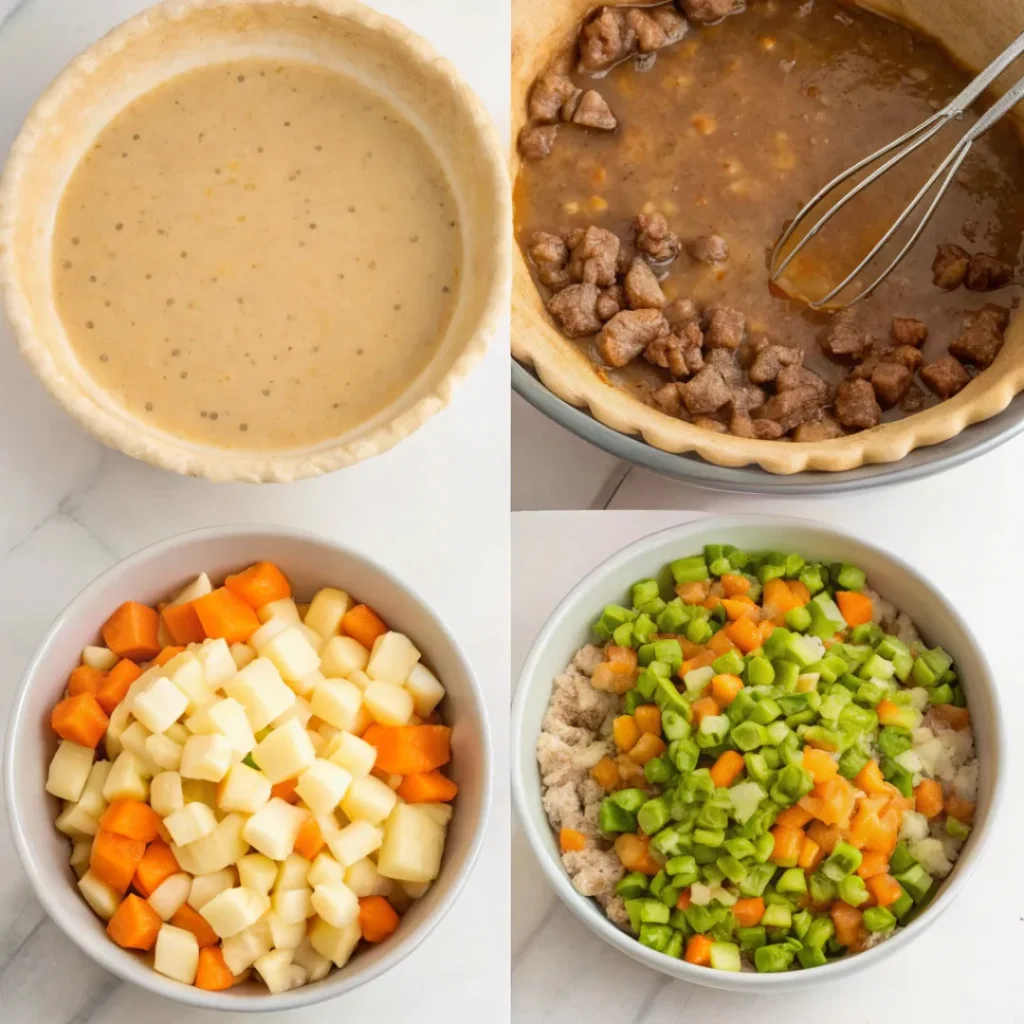Chicken pot pie is the ultimate comfort food—a perfect blend of tender chicken, hearty vegetables, and creamy filling encased in a golden, flaky crust. However, achieving that ideal consistency can be challenging, and a common problem for many home cooks is when their chicken pot pie gets watery, resulting in a runny filling instead of the desired thick, creamy texture. Why does my chicken pot pie get watery? When the filling becomes too thin, it can soak the crust, altering the pie’s appearance, texture, and taste.
This comprehensive guide will explain why your chicken pot pie may become watery and provide practical solutions to prevent it. By understanding common mistakes and learning effective techniques, you can create a pie that holds its shape and boasts a rich, flavorful filling every time.
The Essential Elements of Chicken Pot Pie Filling
Chicken pot pie filling should have a rich, creamy consistency that holds together well without spilling over or becoming too runny. This balance comes from using the right thickening agents, managing the moisture content in each ingredient, and properly cooking the pie. The right consistency makes the difference between a pie that holds its shape and a soupy, unappealing result.
A successful chicken pot pie filling usually contains the following elements:
- Thickening Agents: Flour or cornstarch helps bind the liquid to create a creamy sauce.
- Controlled Liquids: Using the right amount of broth or cream provides flavor without overwhelming the thickener.
- Cooked Ingredients: Vegetables and proteins should be pre-cooked to control their moisture content.
Common Reasons for Watery Chicken Pot Pie
Here’s an in-depth look at the most common reasons that can cause a watery chicken pot pie, along with solutions for each.

Not Enough Thickening Agent
One of the most common causes of a runny filling is not using enough thickening agents, such as flour or cornstarch. A thickening agent binds the liquid in the filling, creating a creamy texture. Without it, the filling is more likely to separate and become runny.
Solution
When making the filling, start by making a roux (a mixture of flour and fat) and gradually add liquid. If you’re using cornstarch, create a slurry by mixing it with cold water before adding it to the filling to prevent clumping.
Excess Moisture from Ingredients
Certain vegetables release a significant amount of water as they cook. Vegetables such as celery, onions, mushrooms, and even carrots contain a lot of moisture, which can dilute the filling if not handled properly.
Solution
Pre-cook high-moisture vegetables like celery, onions, and mushrooms before adding them to the filling. Sautéing or steaming the vegetables removes some of their water content, reducing the risk of excess liquid.
Incorrect Baking Temperature and Time
Baking the pot pie at too low a temperature or for an insufficient amount of time can prevent the filling from setting. Under-baking can leave the filling liquidy, while an overly high temperature may cause the filling to bubble over, leading to separation.
Solution
Bake the pie at a consistent 375°F (190°C) for 45–60 minutes, allowing enough time for the filling to set properly without bubbling over. Avoid overbaking, as it can cause the crust to dry out while the filling remains overly moist.
Using Frozen Ingredients
Frozen ingredients, such as vegetables, release water as they cook. This extra moisture can disrupt the balance of the filling and prevent it from thickening.
Solution
If using frozen vegetables, thaw and drain them thoroughly before adding them to the filling. Alternatively, use fresh vegetables, which contain less water and create a thicker filling.
Skipping Pre-Cooking Steps
Adding raw ingredients directly to the filling can lead to a watery result, as raw vegetables and proteins will release moisture during baking.
Solution
Sauté or steam vegetables before adding them to the filling. This step reduces their moisture content and concentrates their flavor, contributing to a richer, thicker sauce.
Effective Ways to Thicken Chicken Pot Pie Filling
Thickening the filling is essential to achieving the desired consistency. Here are some methods for creating a thick, creamy sauce that holds up in the pie.
Make a Roux or Cornstarch Slurry
Roux
Start by making a roux by cooking equal parts butter and flour over medium heat. Once combined, gradually add broth or cream while stirring constantly to create a smooth, thick sauce.
Cornstarch Slurry
For a quicker option, mix cornstarch with cold water to make a slurry, then add it to the simmering filling.
Use Heavy Cream or Half-and-Half
Adding heavy cream or half-and-half not only thickens the filling but also gives it a rich, creamy texture. Be careful not to overdo it, as too much cream can make the filling too rich or thin.
Reduce Broth or Stock
Too much broth or stock can make the filling runny. Reduce the broth by simmering it to concentrate its flavor and thickness before adding it to the pie filling.
Detailed Step-by-Step Guide to Prevent Watery Filling

Step 1: Choose Ingredients Carefully
Use fresh vegetables instead of frozen ones, as fresh vegetables contain less water. If you must use frozen vegetables, thaw and drain them thoroughly to reduce moisture.
Step 2: Pre-Cook Vegetables and Meat
Sautéing vegetables before adding them to the filling helps reduce their water content. Similarly, pre-cook the chicken to minimize moisture and enhance flavor.
Step 3: Make a Roux or Slurry to Thicken the Filling
Using a roux or cornstarch slurry is one of the most effective ways to thicken the filling. Start by making a roux with flour and butter, then gradually add your liquid, or add a cornstarch slurry toward the end of the cooking process.
Step 4: Limit the Broth or Stock
Add broth in small increments, checking the consistency after each addition. Use only as much as needed to achieve a creamy filling, rather than a watery one.
Step 5: Simmer to Reduce Excess Liquid
If the filling is too watery, let it simmer on the stovetop for a few minutes to evaporate excess liquid. This will concentrate the flavors and create a thicker consistency.
Step 6: Bake at a Consistent Temperature
Bake at a steady 375°F (190°C) to ensure the filling sets properly without separating or bubbling over.
Step 7: Allow the Pie to Cool Before Serving
Letting the pie cool for about 10–15 minutes before serving allows the filling to set, reducing the likelihood of a runny texture.
Additional Tips for Perfect Chicken Pot Pie
Use a Bottom Layer of Breadcrumbs or Crushed Crackers
This layer can help absorb extra moisture from the filling, keeping the crust crisp.
Blind-Bake the Bottom Crust
Pre-baking the bottom crust for a few minutes can help prevent sogginess. After blind-baking, let the crust cool before adding the filling.
Test the Filling Consistency Before Baking
Simmer the filling on the stovetop to test its consistency. It should be thick enough to coat the back of a spoon without running off.
Apply an Egg Wash to the Crust
Brush the crust with an egg wash to promote a golden brown finish without over-baking.
If you want more detailed tips on preventing sogginess, check out this guide on keeping pie crusts crispy.
Frequently Asked Questions
Why Does My Pot Pie Filling Turn Out Watery?
A watery filling is often due to an inadequate amount of thickening agent, too much broth, or high-moisture ingredients. Correct these issues by managing liquid levels and adding a roux or cornstarch slurry.
How Can I Fix Watery Filling Before Baking?
Simmer the filling on the stovetop to reduce excess liquid, or add a cornstarch slurry to thicken it. Let it cook for a few minutes before adding it to the pie.
Is It Okay to Use Frozen Vegetables in Pot Pie?
Yes, but thaw and drain them first to remove excess water. Frozen vegetables release moisture as they cook, which can make the filling watery.
Should I Pre-Cook Vegetables for Chicken Pot Pie?
Yes, pre-cooking vegetables helps to remove excess water and enhances their flavor. Sautéing or steaming vegetables like onions and celery can prevent a watery filling.
Conclusion
Achieving a perfect chicken pot pie with a rich, creamy filling is possible when you understand the factors that contribute to a watery result. A combination of proper thickening techniques, ingredient management, and precise baking times can transform a runny pie into a delicious, satisfying meal. With these tips, you can avoid common mistakes and bake a chicken pot pie that’s thick, flavorful, and holds its shape.
Next time you’re preparing chicken pot pie, keep these methods in mind to prevent watery filling. With a little patience and the right approach, you’ll be able to serve a chicken pot pie that is both visually appealing and deliciously comforting, making it a favorite for family dinners and gatherings alike.

